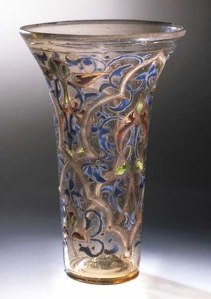Cumbria is home to a number of ‘lucks’, or drinking vessels that are believed to protect a home and its residents from ill fortune. Perhaps the most famous is the Luck of Edenhall.
Edenhall is a small village near Langwathby in the Eden valley, and it was the seat of the Musgrave family for several hundred years.
The Luck is a glass beaker, with blue, green, red and white enamel and gilding, in a case bearing the initials, ‘IHS’ – the Greek rendering of Jesus. The glass is believed to be of Syrian or Egyptian origin, and it was made some time around the 13th or 14th century; a similar one was gifted to the Cathedral of Douai in 1329. The combination of location and date strongly suggest that the glass was brought back from the Crusades.
The Musgraves referred to the glass as their ‘Luck’ at least as early as the 1670s, although a later Musgrave, Sir William, stated in the Gentleman’s Magazine of 1791 that it had been in family hands since the 15th century – the date of their arrival in Edenhall. Despite the nigh-on guaranteed link with a crusader ancestor, by this date, faeries were in the frame (as they so often are in Cumbria!).
He wrote, ‘a party of Fairies were drinking and making merry round a well near the Hall, called St Cuthbert’s well; but being interrupted by the intrusion of some curious people, they were frightened, and made a hasty retreat, and left the cup in question: one of the last screaming out,
“If this cup should break or fall
Farewell the Luck of Edenhall!”.’
Stories of the theft or gift of faery vessels are not uncommon throughout northern Europe.
So, what happened to Edenhall? In 1926, the Luck was sent to the Victoria & Albert Museum, still intact, and it is still there. In 1934, the house at Edenhall was demolished.
There are other ‘Lucks’ in Cumbria, notably:
- The Luck of Muncaster – a vessel given to the castle by Henry VI in 1463.
- The Luck of Burrell Green, near Great Salkeld, dated to c.1417.
- The Luck of Workington – a gift from Mary, Queen of Scots, to Sir Henry Curwen in 1568.
- The Luck of Haresceugh Castle, near Renwick – both vessel and castle have vanished.
- The Luck of Nether Haresceugh – recently still intact.
- The Luck of Skirsgill Hall – just dated to 1732: perhaps they heard about Edenhall!
- The Luck of Rydal Hall – dated to 1736 – ditto.
See http://collections.vam.ac.uk/item/O3311/beaker-and-case-the-luck-of-edenhall/ for the Victoria & Albert Museum’s entry on the Luck of Edenhall. They have the vessel on display.


Just found maybe the first literary reference to the Luck of Edenhall. This is from the 1816 novel Brougham Castle by Jane Harvey, a Newcastle author.
Prudence, a firm believer in the local folklore is remonstrating (in Miss Harvey’s representation of a Cumbrian accent) with her scholarly and disbelieving husband (Crosthwaite):
“Whae said your aunt Kitty was a witch?”, interrupted she, with a look of scorn. “You may flyre an’ laugh,” she added, with increased asperity, “but your aunt Kitty’s seen fairies plenty. Didn’t she say she heard then clap their claise i’ t’ hills at Aldston ? didn’t my mudder see them dance on t’ green? you’ve seen the fairy’s glass at Edenha’ yourself.
“Sud this glass owther break or fa’,
Farewell t’ luck of Edenha’.”
Cyrus,not less interested in the biography of the fairies than he had been in Hercules, now quitted the side of Crosthwaite and stationed himself by that of his wife, listening with profiound attention to the accounts which she gave of numberless children having been, to her knowledge, stolen by pigmies.
Gothic Heroine, you are a star! I suspect the novel may not have been entirely serious even in 1816 – !
I’ve not heard of any fairy reports from Alston (I presume that’s ‘Aldston’), but maybe there are some, going by this. Brilliant. Thank you very much 🙂
Pingback: Elf-shot by mermaids… | Esmeralda's Cumbrian History & Folklore
Pingback: Nominate your favourite blog post on pre-1500 history! | Esmeralda's Cumbrian History & Folklore